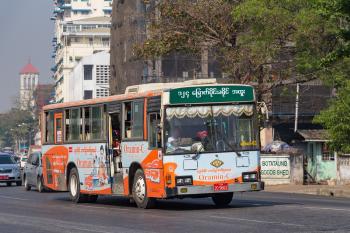Getting Around Yangon
Getting Around Yangon
All City Transport Options: What Locals Use and What’s Best for Tourists
General Overview
Getting around Yangon can be a bit of an adventure! One thing that surprised me about the transport here is how the whole system seems to have its own rhythm. Unlike most cities, you really need to embrace a bit of chaos in order to navigate effectively.Yangon’s public transport is made up of a mix of buses, taxis, and the recent addition of the Yangon's metro. The buses are extensive, with over 100 routes operating from around 6 AM to 10 PM, but they can be a real challenge during rush hour—think tightly packed cabins and people getting on and off at every stop. If you’re like me, crammed at the back of a bus while it's swaying on the road, you might end up missing your stop (been there, done that!). A local hack is to download an app like "City Bus" to help you map out your routes since most bus stops don't have English signage.
One common mistake visitors make is thinking taxis are always the quickest option. Sure, they’re comfortable, but during busy hours, they can be caught in traffic, making bus rides sometimes a better deal. A fare comparison: a typical bus ticket ranges from 200-500 kyats (about $0.10-$0.25), while a taxi from downtown to a landmark like the Shwedagon Pagoda can cost anywhere from 10,000 to 15,000 kyats. Seriously, if you're in a group, consider splitting a taxi— it beats squishing with strangers in the heat.
On the pleasant side, I found the locals to be super friendly. One time, while I was figuring out how to use the bus system at the Hledan stop, a lady took the time to help me out with directions, despite the language barrier.
Oh, before I forget, monsoon season means traffic can get pretty unpredictable. If you’re out during heavy rains, be prepared! Some routes may flood, and buses may take longer, so just be patient.
To wrap everything up, if you’re looking to visit the Bogyoke Aung San Market, catch the bus on Route 20 or grab a ride on the yellow taxi meters that usually start at around 1,000 kyats. Just give yourself plenty of time—rushing isn’t really a thing here!
Types of Transport

popular with tourists
The bus system in Yangon is extensive and covers most key areas, making it a convenient option for tourists to explore the city. Fares typically range from 200 to 500 kyats (about 0.10 to 0.25 USD) per ride, and while cash is the primary payment method, it's best to have small change ready as bus conductors do not always provide change. A key route for tourists is No. 43, which connects downtown to Shwedagon Pagoda, allowing easy access to this iconic landmark. For a smoother journey, try to travel during off-peak hours (mid-morning or early afternoon) to avoid crowded buses. Lastly, keep your belongings secure and be aware of your surroundings, especially in busy markets or during rush hour.
popular with tourists
Walking in Yangon is a fantastic way to explore the city's vibrant culture and historical sites, with many attractions concentrated in areas like downtown and Botahtaung. While walking is free, remember to wear comfortable shoes and stay hydrated, especially during the hot and humid daytime. Key routes include the stroll from Sule Pagoda to the colonial buildings around Pansodan Street, where you can experience local markets and street food along the way.
Be mindful of traffic, as the sidewalks can be uneven, and look out for motorbikes and cars that may come close. For a time-saving tip, start early in the morning to avoid heat and crowds, allowing you to enjoy a more peaceful experience as you admire iconic landmarks like the Shwedagon Pagoda and the charming architecture of the city. Always keep your belongings secure and practice general safety by staying in well-populated areas, especially at night.
Be mindful of traffic, as the sidewalks can be uneven, and look out for motorbikes and cars that may come close. For a time-saving tip, start early in the morning to avoid heat and crowds, allowing you to enjoy a more peaceful experience as you admire iconic landmarks like the Shwedagon Pagoda and the charming architecture of the city. Always keep your belongings secure and practice general safety by staying in well-populated areas, especially at night.

Taxis in Yangon are widely available and can be hailed on the street or booked via popular apps like Grab. The typical cost for short rides within the city starts around 2,000 to 4,000 kyats, depending on the distance, but it’s advisable to negotiate the fare before starting your journey if you’re not using an app. Key routes include travels to popular areas like the Shwedagon Pagoda, Sule Pagoda, and Bogyoke Aung San Market, which are all well-known to taxi drivers. For time-saving, plan your trips during off-peak hours, as traffic can be heavy, particularly in the evenings. Always ensure that the taxi meter is turned on, and for added safety, consider sharing your ride details with a friend via your phone.
Here you can learn about all types of transport in Yangon. What transport is available, how to reach tourist attractions and which mode of transport is optimal.

